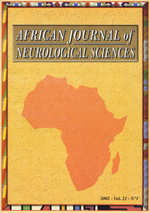
|
African Journal of Neurological Sciences
Pan African Association of Neurological Sciences
ISSN: 1015-8618
Vol. 20, No. 1, 2001, pp. 8-12
|
 Bioline Code: ns01003
Bioline Code: ns01003
Full paper language: English
Document type: Research Article
Document available free of charge
|
|
|
African Journal of Neurological Sciences, Vol. 20, No. 1, 2001, pp. 8-12
| en |
NEUROEPIDEMIOLOGY OF KONZO - A SPASTIC PARA/TETRAPARESIS OF ACUTE ONSET IN A NEW AREA OF THE DEMOCRATIC REPUBLIC OF CONGO
DESIRÉ TSHALA-KATUMBAY, JEAN-PIERRE BANEA-MAYAMBU, THEODORE KAZADI-KAYEMBE, RAPHAËL NUNGA-MATADI, FIDÈLE BIKANGI-NKIABUNGU, KARIN EDEBOL EEG-OLOFSSON, THORKILD TYLLESKÄR4
Abstract
Background:
Konzo is an acute non-progressive spastic paraparesis associated with a consumption
of insufficiently processed bitter cassava, and a low intake of sulfur amino acids.
Method:
To determine whether an outbreak of spastic paraparesis in the Democratic Republic
of Congo was compatible with konzo, we surveyed and screened the population in
the affected area by using the WHO criteria. Interviews and focus group discussions
were done on diet and the occurrence of konzo. Serum samples were analyzed for
prealbumin, albumin and thiocyanate; urine samples for linamarin, thiocyanate
and sulfate. Serum samples were tested for HIV 1-2 (Behring ELISA) and HTLV I-II
antibodies (ELISA/Wellcome).
Results:
Of 2,723 inhabitants, 55 were affected by konzo i.e. a prevalence of 20 per thousand.
The main symptom was a sudden onset of a non-progressive spastic paraparesis or
a tetraparesis in severe cases. Bitter cassava was the staple diet. We found high
exposure to cyanogenic compounds i.e., mean (± SD) concentration of serum
thiocyanate 502 (±153) mmol/L, of urinary linamarin 482 (±322) mmol/L,
and urinary thiocyanate 1128 (±670) mmol/L. The mean (± SD) urinary
sulfate concentration was 4.0 ± 3.3 mmol/L. Most subjects had low proteins
concentration in serum: of 38 subjects 37 and 28 were below the albumin and prealbumin
reference values respectively. All 38 blood samples were negative to the tested
retroviruses.
Conclusion:
This outbreak was compatible with konzo. Improving cassava processing might prevent
the disease.
Keywords
acute spastic paraparesis, , cassava, cyanogens exposure, konzo
|
| |
| fr |
DESIRÉ TSHALA-KATUMBAY, JEAN-PIERRE BANEA-MAYAMBU, THEODORE KAZADI-KAYEMBE, RAPHAËL NUNGA-MATADI, FIDÈLE BIKANGI-NKIABUNGU, KARIN EDEBOL EEG-OLOFSSON, THORKILD TYLLESKÄR4
Résumé
Description:
Le Konzo est une paraparésie spastique permanente, à début brutal,
associée à la consommation de manioc insuffisamment traité avec
une alimentation pauvre en acides aminés soufrés.
Objectif:
Déterminer si une épidémie de paraparésie spastique en République
Démocratique du Congo était compatible avec le konzo.
Methode:
Un dépistage des cas de konzo a été effectué au moyen des
critères de l' OMS. Des interviews ont été réalisées
sur l'alimentation et la maladie. Les taux sériques de préalbumine,
albumine et thiocyanate furent mesurés ainsi que ceux de linamarine, thiocyanate
et sulfate dans les urines. Les serums furent testés pour HIV 1-2 (Behring
ELISA) et HTLV I-II (ELISA/Wellcome).
Resultats:
Sur 2.723 habitants, 55 étaient affectés par le konzo, soit une prévalence
de 20 pour mille. Le symptôme majeur était une paraparésie spastique
permanente à début brutal ou une tétraparésie dans les cas
sévères, le manioc amer était l' aliment de base. Il y avait une
importante exposition aux substances cyanogénétiques: concentration
moyenne (± écart-type) de thiocyanate sérique 502 (±153) mmol/L,
de linamarine urinaire 482 (±322) mmol/L, de thiocyanate urinaire 1128 (±670)
mmol/L. La concentration moyenne (± écart-type) de sulfate urinaire
était 4.0 ± 3.3 mmol/L. En majorité, le taux des protéines
sériques était en dessous de la normale: sur 38 sujets, 37 et 28 l'avait
pour l'albumine et la préalbumine respectivement. Tous les 38 serums collectés
étaient négatifs aux rétrovirus testés.
Conclusion:
Cette épidémie était compatible avec le konzo. Ameliorer le traitement
du manioc peut prevenir la maladie.
Mots Clés
manioc, konzo, paraparésie spastique aigue, substances cyanogènes
|
| |
© Copyright 2001 - African Journal of Neurological Sciences
Alternative site location: http://www.ajns.paans.org
|
|
